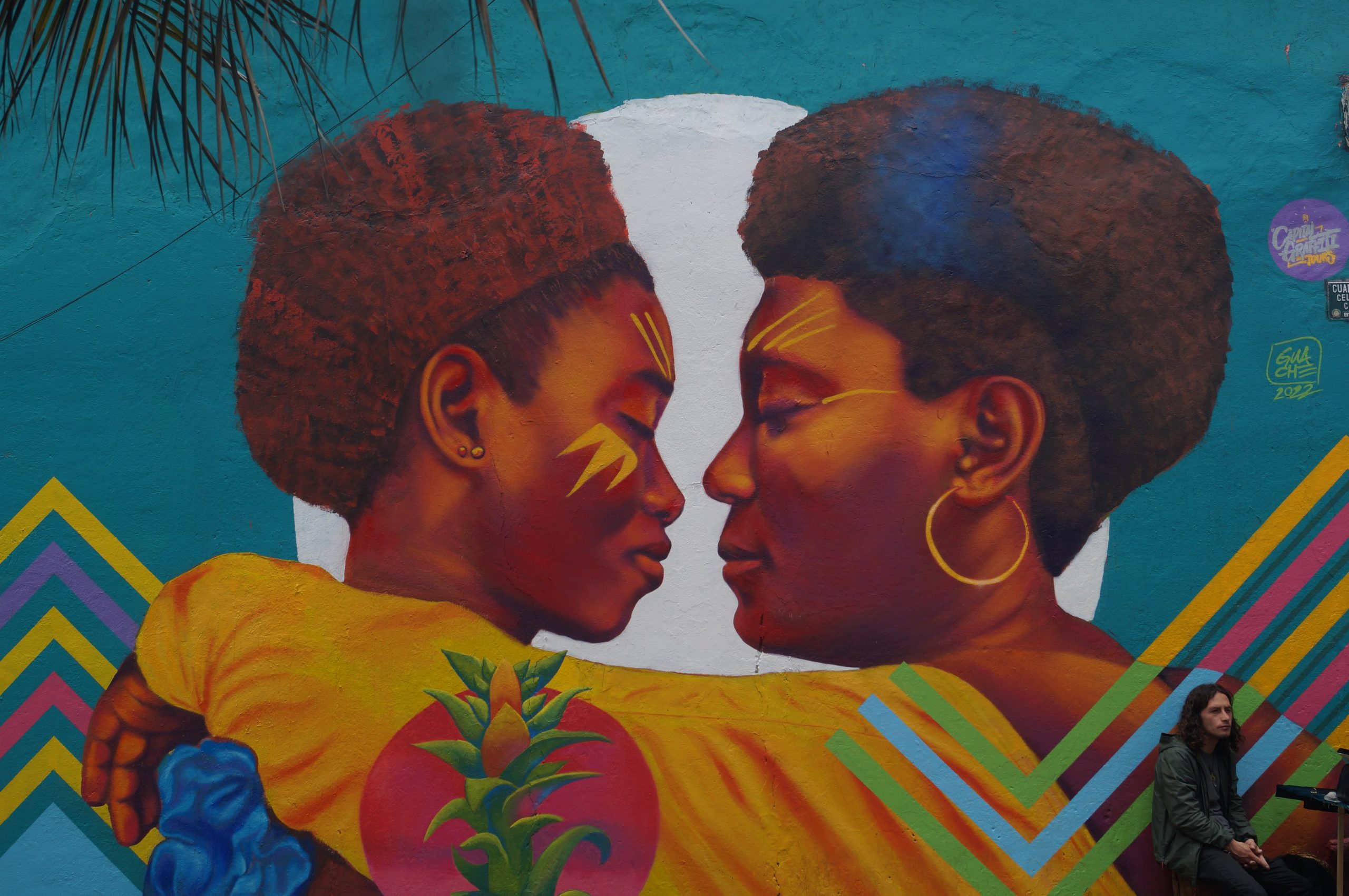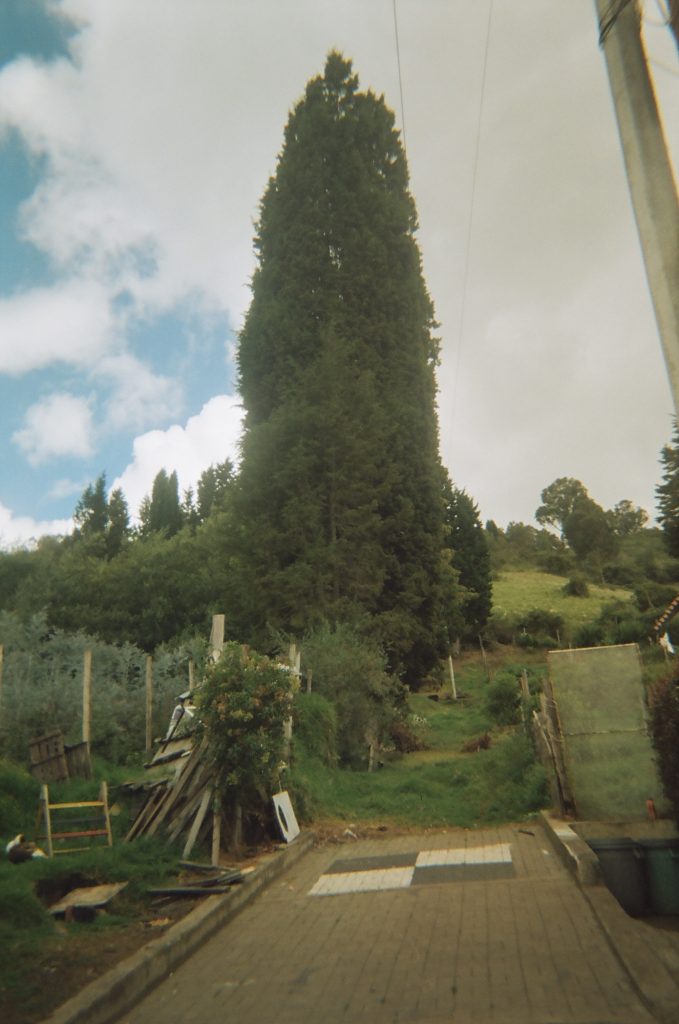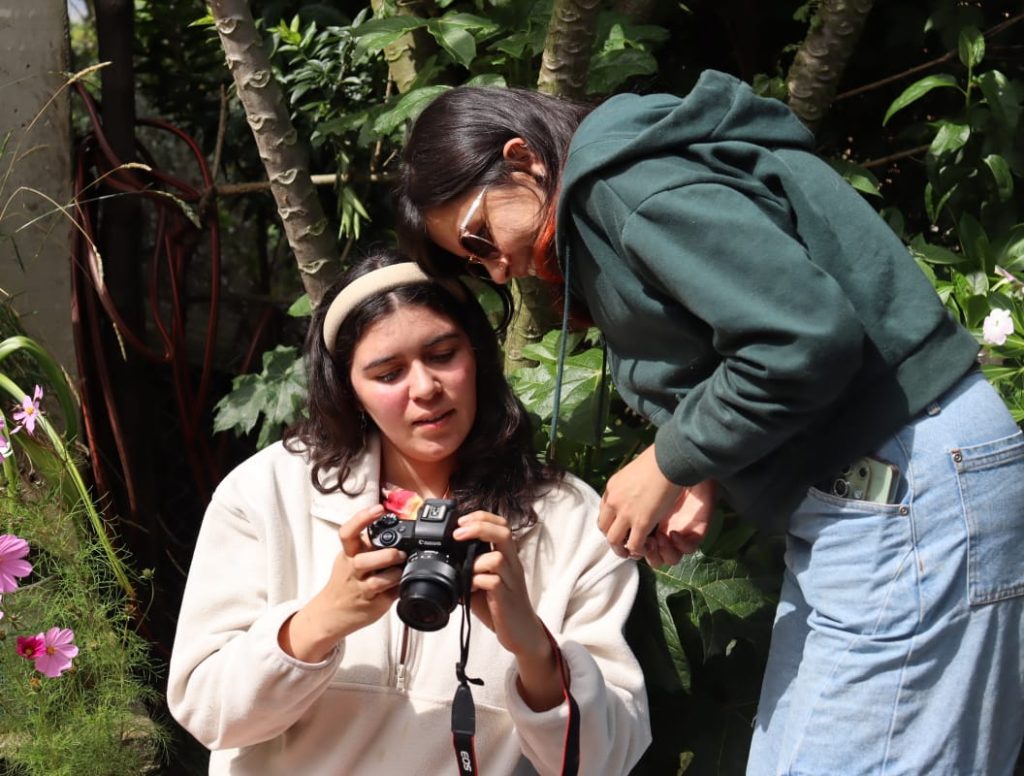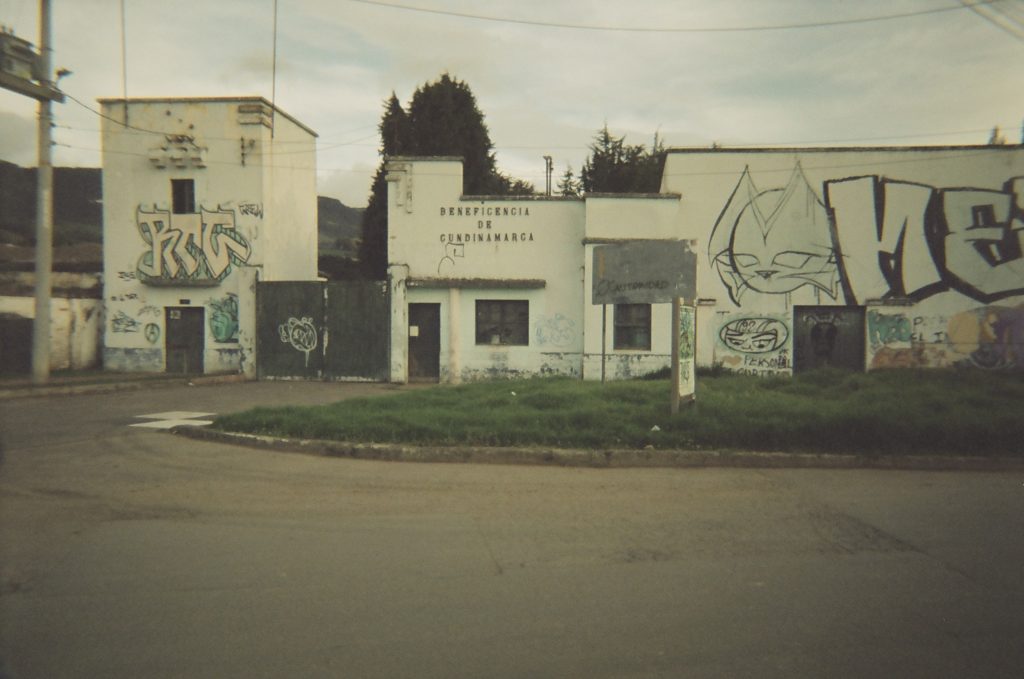Bogotá is an open-air museum. Yuly Pico is my guide. She fell in love with graffiti when she started working for the Bogotá Graffiti Tour. Once, she wanted to become a graffiti artist herself. “But it wasn’t for me,” she says, laughing, “so I continued as a connoisseur.”
Breaking the stigma around graffiti is what she loves most about her work. That’s why she prefers to talk about street art. The murals we explore together are not hastily drawn tags, but pieces that artists have worked on for days, covering entire facades.
However, the graffiti culture in Bogotá also started with tagging—the quick signature left by an artist—under the influence of the North American hip-hop scene. Soon, this technique was also used to spread political messages, usually anarchist or left-leaning. “But I also see it as a way of saying ‘I exist,’” Yuly explains. ”Many people who tag belong to marginalised groups. They want to show themselves in a city that rejects or discriminates against them.

Tags at Parque de los Periodistas, Bogotá.
Artist 3TRA started ten years ago, when street art was not yet tolerated, by putting up posters, a popular subgenre in Colombian street art. She describes the work she did with her art collective Caníbal as anarchistic and surreal: “We mostly drew whatever came to mind, and it didn’t need to have any meaning. We were very punk, you could see that in our way of working (laughs): a group of women would hit the streets of Bogotá to hang posters. We did it anonymously. We didn’t want to earn anything or achieve any goal. It just made us happy.”
Street art in Bogotá occupies a grey area. It’s tolerated, but technically illegal. Ten years ago, this form of art was completely criminalised. 3TRA was lucky to only pay a fine when caught tagging by the police. Yuly tells me how differently things could go.
From Stigma to Protest
August 19, 2011, is a date etched in the memory of every street artist, as it’s the day the police shot and killed sixteen-year-old Diego Felipe Becerra while he was tagging along Avenida Boyacá. “This is the sad part of the history of Colombian street art,” Yuly says, referring to the long-standing association with crime and vandalism. “In some cases, graffiti is indeed a form of vandalism, like when an artist paints a wall without permission. But I struggle with the idea that street art was long regarded as a criminal act. Walking around with a paintbrush or spray can with the intent to create art is not the same as carrying an illegal weapon to intimidate or rob someone. Yet the police didn’t seem to make that distinction.”
The killing of a minor for a tag sparked outrage. The turning point finally came three years later when Canadian rapper Justin Bieber performed in the capital and drew a marijuana leaf on a wall. The police protected him and even closed off the street for him. “In the aftermath of Diego Felipe Becerra’s death, this was a slap in the face for our street artists,” Yuly recalls. “Why should they be punished when a foreign rapper is escorted and protected by the same police to paint a marijuana leaf?”
Bieber triggered a chain reaction. As a form of protest against the criminalization of street art, about 300 street artists united and created over 700 murals within 24 hours. During the demonstration, the solidarity among the artists was remarkable. They helped each other finish the artwork, lending paint and other materials—expensive supplies not every artist could afford at the time. More importantly, the police not only tolerated the demonstration but even encouraged it.
The day of the demonstration forever changed Bogotá’s streets. Artists shed their negative image, and their work was no longer labelled as vandalism. On the contrary, street art has even become a common way to combat vandalism. Many residents now give permission for their facades to be painted to prevent unwanted tags. Additionally, for business owners, it has become an efficient way to promote their businesses. A restaurant or shop with a mural-painted facade attracts more customers.
“The murals we had painted here aren’t just a clever marketing ploy,” says the owner of Casa Colibrí, who had the entire alley next to his hostel painted. “Even more important is how street art can transform a neighbourhood. Five years ago, this alley was an unsafe place where drugs were used, and homeless people harassed my customers. Most of the walls were covered in curse words. Thanks to the murals, the alley has come back to life and has become a beloved spot in the city. It even has its own Instagram account.”
3TRA’s artistic journey mirrors the broader movement in Bogotá, where graffiti evolved from a criminal act to an accepted form of artistic expression. Still, she operates both legally and illegally. She puts up posters in public spaces without permission—a conscious act of resistance against the inequality in the enforcement of laws: “It’s ridiculous that companies can cover walls with ads without consequences, but when we create street art, it’s suddenly illegal.” She emphasises the double standard street artists continue to face in the city. On the other hand, she regularly participates in projects subsidised by the same city. “It doesn’t get more legal than that. Plus, I make some money from it. Not much, because this is still Colombia (laughs).”
She stresses that she doesn’t participate in city projects for the money but to gain more recognition. Earning that recognition is hard work, and established artists often get priority. “Every street artist works to earn that name,” she says, “but emerging artists are often left behind.” Moreover, these projects often limit artistic freedom. There are requirements for the theme, colours, or size. This is one of the reasons 3TRA continues to spread her work without permission. In that, she can be completely herself, despite the risks. She also shares the view of famous street artists like Stinkfish, who says street art is inherently illegal: “I fully agree with that. That’s how it started, and that’s how it will remain.”

A Work by Stinkfish, La Candelaria, Bogotá.
The Street: A Voice for Everyone
Nowhere in the world do street art and activism come as close together as they do in the Colombian capital. Although 3TRA often struggles with the limitations and inequalities of subsidised projects, street art remains for her a powerful way to express herself and address societal issues. Just as she claims her own space for this, the political and social dimensions of graffiti remain inseparable from the streets of Bogotá.
Street art in Bogotá follows the trends of what resonates with the people. It reflects the country’s social and political tensions. A current theme is Colombia’s fauna and flora. This topic is closely tied to the global fight against climate change and the concern over the extinction of native plants and animals. Many murals point to the destruction of nature around the capital, often caused by companies exploiting resources. “The mountains you see around Bogotá weren’t always as green as they are now,” Yuly tells me. “For years, we destroyed our environment, and only recently has attention been drawn to this. Graffiti not only highlights problems but also raises awareness among the population.”

Mural en La Candelaria, Bogotá.
Another aspect of graffiti is that it provides a visual voice for marginalised and forgotten groups, such as indigenous peoples and Afro-Colombians. One of the most influential artists in this area is Guache, whose name means “warrior” in Chibcha. Oscar González, his real name, uses bright colours and psychedelic patterns to create portraits of indigenous and Afro-Colombian communities. His work blends traditional mural techniques with modern graffiti styles, bringing forth not only his roots but also a social struggle.

A Work by Guache, Chorro de Quevedo Plaza, Bogotá.
Another influential artist is ERRE, Bogotá’s first female graffiti artist. Her work is heavily inspired by the punk scene and focuses on life as a woman in the capital. Like Guache, she uses her art as a form of resistance and activism, bringing personal and social issues to the public space.

A Work by ERRE, La Candelaria, Bogotá.
Beyond raising awareness about social issues, graffiti also serves as an alternative news medium, especially in times of protest and conflict. Yuly shows me a portrait of a young man. The caption reads, “En memoria de Dilan Cruz.” In 2019, Latin America was hit by a wave of protests and demonstrations. In Bogotá, graffiti became an effective way to spread political messages and news, given the censorship in mainstream media. When eighteen-year-old Dilan Cruz was shot by the police during one of these protests, the conflict escalated. Cruz became a symbol of this protest wave and is still commemorated in street art; his portraits can be seen all over the city.

En memoria de Dilan Cruz, La Candelaria, Bogotá.
The streets of Bogotá are a place where people can speak freely and meet one another, a space where ideas and feelings are openly shared. Street art has become an important communication tool because it escapes the filters of censorship. “We can truly say what we think because we’re anonymous,” 3TRA explains. The elusive nature of graffiti makes it difficult to regulate, making it an effective counteraction to the suppression of free speech. “If you read the newspaper, you remain ignorant,” 3TRA adds, highlighting that the street is often the only place where the truth is visible—unfiltered and uncensored: “The street is a voice for everyone.”





